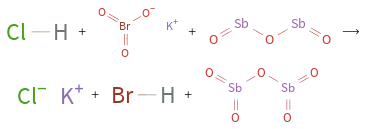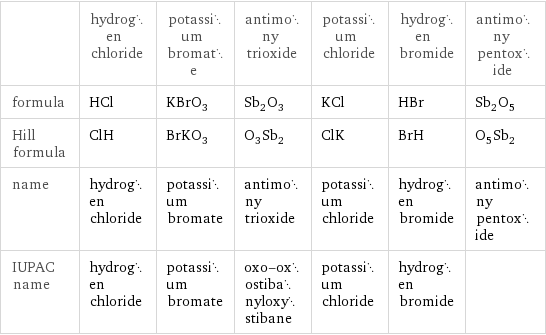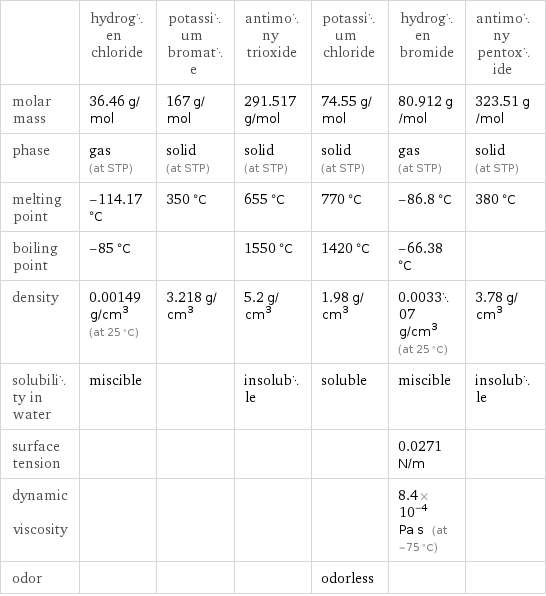Input interpretation

HCl hydrogen chloride + KBrO_3 potassium bromate + Sb_2O_3 antimony trioxide ⟶ KCl potassium chloride + HBr hydrogen bromide + Sb_2O_5 antimony pentoxide
Balanced equation

Balance the chemical equation algebraically: HCl + KBrO_3 + Sb_2O_3 ⟶ KCl + HBr + Sb_2O_5 Add stoichiometric coefficients, c_i, to the reactants and products: c_1 HCl + c_2 KBrO_3 + c_3 Sb_2O_3 ⟶ c_4 KCl + c_5 HBr + c_6 Sb_2O_5 Set the number of atoms in the reactants equal to the number of atoms in the products for Cl, H, Br, K, O and Sb: Cl: | c_1 = c_4 H: | c_1 = c_5 Br: | c_2 = c_5 K: | c_2 = c_4 O: | 3 c_2 + 3 c_3 = 5 c_6 Sb: | 2 c_3 = 2 c_6 Since the coefficients are relative quantities and underdetermined, choose a coefficient to set arbitrarily. To keep the coefficients small, the arbitrary value is ordinarily one. For instance, set c_1 = 1 and solve the system of equations for the remaining coefficients: c_1 = 1 c_2 = 1 c_3 = 3/2 c_4 = 1 c_5 = 1 c_6 = 3/2 Multiply by the least common denominator, 2, to eliminate fractional coefficients: c_1 = 2 c_2 = 2 c_3 = 3 c_4 = 2 c_5 = 2 c_6 = 3 Substitute the coefficients into the chemical reaction to obtain the balanced equation: Answer: | | 2 HCl + 2 KBrO_3 + 3 Sb_2O_3 ⟶ 2 KCl + 2 HBr + 3 Sb_2O_5
Structures

+ + ⟶ + +
Names

hydrogen chloride + potassium bromate + antimony trioxide ⟶ potassium chloride + hydrogen bromide + antimony pentoxide
Equilibrium constant
![Construct the equilibrium constant, K, expression for: HCl + KBrO_3 + Sb_2O_3 ⟶ KCl + HBr + Sb_2O_5 Plan: • Balance the chemical equation. • Determine the stoichiometric numbers. • Assemble the activity expression for each chemical species. • Use the activity expressions to build the equilibrium constant expression. Write the balanced chemical equation: 2 HCl + 2 KBrO_3 + 3 Sb_2O_3 ⟶ 2 KCl + 2 HBr + 3 Sb_2O_5 Assign stoichiometric numbers, ν_i, using the stoichiometric coefficients, c_i, from the balanced chemical equation in the following manner: ν_i = -c_i for reactants and ν_i = c_i for products: chemical species | c_i | ν_i HCl | 2 | -2 KBrO_3 | 2 | -2 Sb_2O_3 | 3 | -3 KCl | 2 | 2 HBr | 2 | 2 Sb_2O_5 | 3 | 3 Assemble the activity expressions accounting for the state of matter and ν_i: chemical species | c_i | ν_i | activity expression HCl | 2 | -2 | ([HCl])^(-2) KBrO_3 | 2 | -2 | ([KBrO3])^(-2) Sb_2O_3 | 3 | -3 | ([Sb2O3])^(-3) KCl | 2 | 2 | ([KCl])^2 HBr | 2 | 2 | ([HBr])^2 Sb_2O_5 | 3 | 3 | ([Sb2O5])^3 The equilibrium constant symbol in the concentration basis is: K_c Mulitply the activity expressions to arrive at the K_c expression: Answer: | | K_c = ([HCl])^(-2) ([KBrO3])^(-2) ([Sb2O3])^(-3) ([KCl])^2 ([HBr])^2 ([Sb2O5])^3 = (([KCl])^2 ([HBr])^2 ([Sb2O5])^3)/(([HCl])^2 ([KBrO3])^2 ([Sb2O3])^3)](../image_source/cfb68f969e90ad10f1dc5f3a8ac3c8fc.png)
Construct the equilibrium constant, K, expression for: HCl + KBrO_3 + Sb_2O_3 ⟶ KCl + HBr + Sb_2O_5 Plan: • Balance the chemical equation. • Determine the stoichiometric numbers. • Assemble the activity expression for each chemical species. • Use the activity expressions to build the equilibrium constant expression. Write the balanced chemical equation: 2 HCl + 2 KBrO_3 + 3 Sb_2O_3 ⟶ 2 KCl + 2 HBr + 3 Sb_2O_5 Assign stoichiometric numbers, ν_i, using the stoichiometric coefficients, c_i, from the balanced chemical equation in the following manner: ν_i = -c_i for reactants and ν_i = c_i for products: chemical species | c_i | ν_i HCl | 2 | -2 KBrO_3 | 2 | -2 Sb_2O_3 | 3 | -3 KCl | 2 | 2 HBr | 2 | 2 Sb_2O_5 | 3 | 3 Assemble the activity expressions accounting for the state of matter and ν_i: chemical species | c_i | ν_i | activity expression HCl | 2 | -2 | ([HCl])^(-2) KBrO_3 | 2 | -2 | ([KBrO3])^(-2) Sb_2O_3 | 3 | -3 | ([Sb2O3])^(-3) KCl | 2 | 2 | ([KCl])^2 HBr | 2 | 2 | ([HBr])^2 Sb_2O_5 | 3 | 3 | ([Sb2O5])^3 The equilibrium constant symbol in the concentration basis is: K_c Mulitply the activity expressions to arrive at the K_c expression: Answer: | | K_c = ([HCl])^(-2) ([KBrO3])^(-2) ([Sb2O3])^(-3) ([KCl])^2 ([HBr])^2 ([Sb2O5])^3 = (([KCl])^2 ([HBr])^2 ([Sb2O5])^3)/(([HCl])^2 ([KBrO3])^2 ([Sb2O3])^3)
Rate of reaction
![Construct the rate of reaction expression for: HCl + KBrO_3 + Sb_2O_3 ⟶ KCl + HBr + Sb_2O_5 Plan: • Balance the chemical equation. • Determine the stoichiometric numbers. • Assemble the rate term for each chemical species. • Write the rate of reaction expression. Write the balanced chemical equation: 2 HCl + 2 KBrO_3 + 3 Sb_2O_3 ⟶ 2 KCl + 2 HBr + 3 Sb_2O_5 Assign stoichiometric numbers, ν_i, using the stoichiometric coefficients, c_i, from the balanced chemical equation in the following manner: ν_i = -c_i for reactants and ν_i = c_i for products: chemical species | c_i | ν_i HCl | 2 | -2 KBrO_3 | 2 | -2 Sb_2O_3 | 3 | -3 KCl | 2 | 2 HBr | 2 | 2 Sb_2O_5 | 3 | 3 The rate term for each chemical species, B_i, is 1/ν_i(Δ[B_i])/(Δt) where [B_i] is the amount concentration and t is time: chemical species | c_i | ν_i | rate term HCl | 2 | -2 | -1/2 (Δ[HCl])/(Δt) KBrO_3 | 2 | -2 | -1/2 (Δ[KBrO3])/(Δt) Sb_2O_3 | 3 | -3 | -1/3 (Δ[Sb2O3])/(Δt) KCl | 2 | 2 | 1/2 (Δ[KCl])/(Δt) HBr | 2 | 2 | 1/2 (Δ[HBr])/(Δt) Sb_2O_5 | 3 | 3 | 1/3 (Δ[Sb2O5])/(Δt) (for infinitesimal rate of change, replace Δ with d) Set the rate terms equal to each other to arrive at the rate expression: Answer: | | rate = -1/2 (Δ[HCl])/(Δt) = -1/2 (Δ[KBrO3])/(Δt) = -1/3 (Δ[Sb2O3])/(Δt) = 1/2 (Δ[KCl])/(Δt) = 1/2 (Δ[HBr])/(Δt) = 1/3 (Δ[Sb2O5])/(Δt) (assuming constant volume and no accumulation of intermediates or side products)](../image_source/88ec9a4c0c52e831893ccaec0504a924.png)
Construct the rate of reaction expression for: HCl + KBrO_3 + Sb_2O_3 ⟶ KCl + HBr + Sb_2O_5 Plan: • Balance the chemical equation. • Determine the stoichiometric numbers. • Assemble the rate term for each chemical species. • Write the rate of reaction expression. Write the balanced chemical equation: 2 HCl + 2 KBrO_3 + 3 Sb_2O_3 ⟶ 2 KCl + 2 HBr + 3 Sb_2O_5 Assign stoichiometric numbers, ν_i, using the stoichiometric coefficients, c_i, from the balanced chemical equation in the following manner: ν_i = -c_i for reactants and ν_i = c_i for products: chemical species | c_i | ν_i HCl | 2 | -2 KBrO_3 | 2 | -2 Sb_2O_3 | 3 | -3 KCl | 2 | 2 HBr | 2 | 2 Sb_2O_5 | 3 | 3 The rate term for each chemical species, B_i, is 1/ν_i(Δ[B_i])/(Δt) where [B_i] is the amount concentration and t is time: chemical species | c_i | ν_i | rate term HCl | 2 | -2 | -1/2 (Δ[HCl])/(Δt) KBrO_3 | 2 | -2 | -1/2 (Δ[KBrO3])/(Δt) Sb_2O_3 | 3 | -3 | -1/3 (Δ[Sb2O3])/(Δt) KCl | 2 | 2 | 1/2 (Δ[KCl])/(Δt) HBr | 2 | 2 | 1/2 (Δ[HBr])/(Δt) Sb_2O_5 | 3 | 3 | 1/3 (Δ[Sb2O5])/(Δt) (for infinitesimal rate of change, replace Δ with d) Set the rate terms equal to each other to arrive at the rate expression: Answer: | | rate = -1/2 (Δ[HCl])/(Δt) = -1/2 (Δ[KBrO3])/(Δt) = -1/3 (Δ[Sb2O3])/(Δt) = 1/2 (Δ[KCl])/(Δt) = 1/2 (Δ[HBr])/(Δt) = 1/3 (Δ[Sb2O5])/(Δt) (assuming constant volume and no accumulation of intermediates or side products)
Chemical names and formulas

| hydrogen chloride | potassium bromate | antimony trioxide | potassium chloride | hydrogen bromide | antimony pentoxide formula | HCl | KBrO_3 | Sb_2O_3 | KCl | HBr | Sb_2O_5 Hill formula | ClH | BrKO_3 | O_3Sb_2 | ClK | BrH | O_5Sb_2 name | hydrogen chloride | potassium bromate | antimony trioxide | potassium chloride | hydrogen bromide | antimony pentoxide IUPAC name | hydrogen chloride | potassium bromate | oxo-oxostibanyloxystibane | potassium chloride | hydrogen bromide |
Substance properties

| hydrogen chloride | potassium bromate | antimony trioxide | potassium chloride | hydrogen bromide | antimony pentoxide molar mass | 36.46 g/mol | 167 g/mol | 291.517 g/mol | 74.55 g/mol | 80.912 g/mol | 323.51 g/mol phase | gas (at STP) | solid (at STP) | solid (at STP) | solid (at STP) | gas (at STP) | solid (at STP) melting point | -114.17 °C | 350 °C | 655 °C | 770 °C | -86.8 °C | 380 °C boiling point | -85 °C | | 1550 °C | 1420 °C | -66.38 °C | density | 0.00149 g/cm^3 (at 25 °C) | 3.218 g/cm^3 | 5.2 g/cm^3 | 1.98 g/cm^3 | 0.003307 g/cm^3 (at 25 °C) | 3.78 g/cm^3 solubility in water | miscible | | insoluble | soluble | miscible | insoluble surface tension | | | | | 0.0271 N/m | dynamic viscosity | | | | | 8.4×10^-4 Pa s (at -75 °C) | odor | | | | odorless | |
Units
